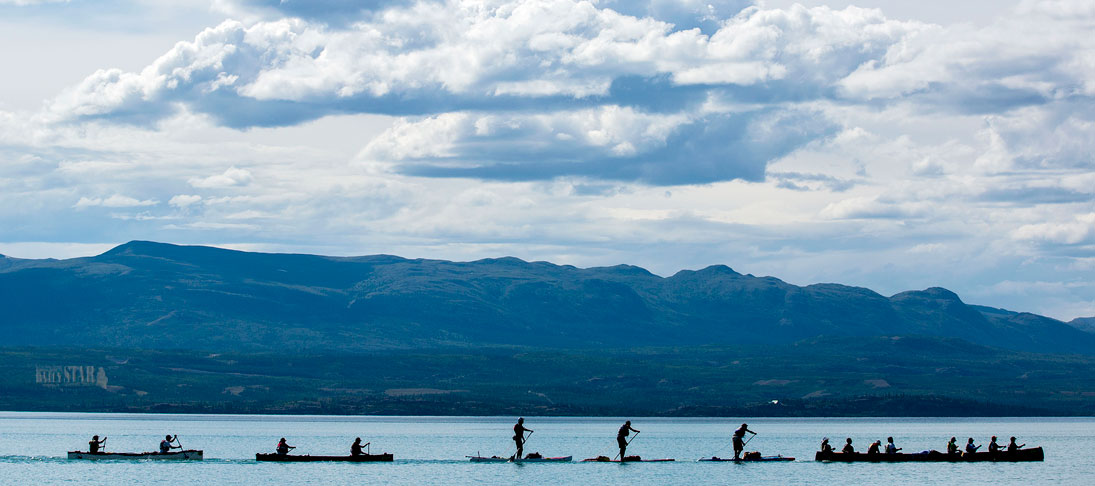Yukon River Quest 2017 expected prize purse increases by $2,700
More than $39,000 is expected to be disbursed at the conclusion of next year’s Yukon River Quest.
By Whitehorse Star on October 21, 2016
Official race rules updated: two classes added, late registration opportunities and drafting clause included
More than $39,000 is expected to be disbursed at the conclusion of next year’s Yukon River Quest.
Cash prizes will be available for the top three boats in all classes.
As in other years, a cash prize will go to the top three overall boats in a class, in addition to the top three in a division (men’s, women’s, mixed).
There are also cash prizes for the top Yukon canoe, kayak, and the top First Nation team.
If the race is full at 100 boats, tandem canoes and kayaks will receive $1,100 for first place, $525 for second and $325 for third.
With the addition of standup paddleboards (SUP) as an official class, a new column of prize money was added, said media director Jeff Brady. With a full race, solo boats are apt to receive $900 for first, $400 for second and $325 for
third.
The newest class, C-4 has been added under the voyageur domain and will be included in that category for prize money and overall placing. First boat receives $2,200, while second gets $975 and third receives $475.
The official rules for the 2017 race were released this week. Here are a few more highlights:
C-4 joins the River Quest
“Every year we get requests from all kinds of boats from row boats to outriggers,” said Brady. “The C-4 seems to be the best fit without having to change any rules.”
The C-4s will join the voyageur canoe class, but will not count towards the voyageur cap of 15 boats – due to space restriction along the river, especially at Carmacks Checkpoint.
“If they become popular, they may end up being their own class,” said Brady.
However, Brady thinks there may be one C-4 stock boat that meets the race rules’ requirements in the Yukon, meaning those interested in the event will likely have to bring their own vessels up, like the SUPs.
Drafting consequences
No official drafting protests were filed in 2016, but reports from the river had race organizers considering a change in policy.
In the past, mention of drafting was only in the pre-race powerpoint that all racers must attend, for the 2017 race however, drafting made it into the rule book.
“We’ve beefed up some of the language regarding interference and made drafting guidelines part of the rules,” said Brady.
Rule 21a stipulates that drafting is allowed, but within certain parameters.
In-class drafting is allowed, but equal time leading and wake-riding is expected. Out-of-class drafting is allowed (for example a SUP and a voyageur), but must be agreed upon by all boats involved.
Any preplanned draft strategies between boats could result in disqualification, as it would be regarded as a pace boat (prohibited under rule 19 “Team Support”).
“It’s really not fair to everyone,” said Brady. “But to help people get across the lake, maybe it’s okay.”
His indecision is telling, as a past multiple-time participant and finisher of the race, he knows the river well and the misery that Lake Laberge can inflict upon paddlers.
The lake was kind last summer, but some boats still chose to draft, including the top three SUPs, who drafted behind an agreeable voyageur for a large section of the lake.
Drafting rules are revisited every year.
Little Salmon shifts to
monitoring point
With the improvement of technology and the addition of an inReach or SPOT device in the paddlers’ race kit, the need for a checkpoint at Little Salmon has become redundant.
“It’s really become unessecary,” said Brady. “With the advent of tracking, SPOT and inReach, we can know within a few minutes when a team is going to arrive in Carmacks.”
Brady said that a handful of years ago, the race organizers relied on radio info from volunteers at the Little Salmon Checkpoint and safety boats on the water to track when paddlers would arrive at the Carmacks Checkpoint, where
seven hours of rest are required. Little Salmon monitoring point is about 60 kilometres upstream of Carmacks.
Times are still getting jotted down by the monitoring point volunteers.
There will be eight monitoring points and five checkpoints in next year’s race. The locations remain unchanged.
Late registration
Late registration has been added at an additional charge of $150 after May 15.
“We were really encouraged by the numbers last year, but we feel like we may be losing a chance to get people in at
the last minute,” said Brady. “It’s going to cost them a little more, but at least it would give people the opportunity to sign up.”
The rule may help benefit local teams, if there are still spots open after eight months.
Registration closes on June 15, 2017, when numbers will be assigned to teams.
Registration for the 2017 Yukon River Quest will open Nov.1 at 12:01 a.m.

Be the first to comment